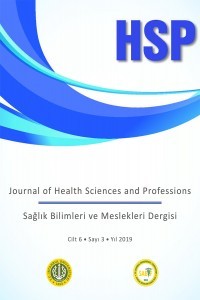Öğrencilerin Rahatta (Konforda) Bozulma Hemşirelik Tanısını Belirleme Durumlarının Saptanması
hemşirelik süreci, Rahatta (Konforda) Bozulma, hemşirelik öğrencileri
Determination of Students' Identification of Comfort Corruption Nursing Diagnoses
Nursing process, deterioration in comfort,
___
- Ay F. Uluslararası Alanda Kullanılan Hemşirelik Tanıları ve Uygulamaları Sınıflandırma Sistemleri [International Classification Systems of Nursing Diagnosis and Practices: Medical Education].Türkiye Klinikleri dergisi [J Med Sci] 2008; 28: 555-561.
- Sabuncu N. [Hemşirelik süreci]. Sabuncu N, editör. Hemşirelik bakımında ilke ve uygulamalar. Alter Yayıncılık; 2008: 137-141.
- Keski Ç, Karadağ A. Hemşirelik Son Sınıf Öğrencilerinin Hemşirelik Süreci Hakkındaki Bilgi Düzeylerinin İncelenmesi [Investigation of Knowledge Levels of Final Year Nursing Students Regarding Nursing Process]. Hemşirelikte Araştırma Geliştirme Dergisi [Turkish Journal Of Research & Development In Nursing] 2010;12(1):41-52.
- Birol L. Hemşirelik Süreci [Hemşirelik Süreci aşamaları]. 7. Baskı. İzmir: Etki Matbaacılık; 2005, s. 97-99.
- World Health Organization (WHO), (1994) Lemon learning material on nursing. Chapter 4: Nursing process and documentation 2009; 1(1): 96.
- Yıldırım B, Koç ŞÖ. Eleştirel Düşünmeyi Hemşirelik Sürecinde Uygulama [Nursıng Process Applıcatıon In Crıtıcal Thınkıng]. Meslek Yüksekokullarının Elektronik Dergisi [Electronic Journal of Vocational Colleges] 2013;3(3):29-35.
- Kaya N, Babadağ K, Yeşiltepe KG, Uygur E. Hemşirelerin Hemşirelik Model/Kuramlarını, Hemşirelik Sürecini ve Sınıflama Sistemlerini Bilme ve Uygulama Durumları [Nurses’ Nursing Model / Theory, Nursing Process, and Classification Systems Know and Implication Status]. Maltepe Üniversitesi Hemşirelik Bilim ve Sanatı Dergisi [Maltepe University Nursing Science and Art Review] 2010;3(3): 24-33.
- Türkiye Cumhuriyeti Başbakanlığı. T.C Resmi Gazete, Hemşirelik Kanununda Değişiklik Yapılmasına Dair Kanun 2007/26510: 1. (Güncellenme Tarihi: 2 Mayıs 2007). Erişim adresi:http://www.resmigazete.gov.tr/eskiler/2007/05/20070502-3.htm.
- Özer FG, Kuzu N. Öğrencilerin bakım planlarında hemşirelik süreci ve NANDA tanılarını kullanma durumları [The Status Of Students' Use Of Nursıng Process And Nanda Dıagnoses In Theır Care Plans] Ege Üni.Hemşirelik Yüksek Okulu Dergisi [Journal of Ege Unıversıty Nursıng Faculty] 2006; 22 (1): 69-80.
- Erdemir F, Çırlak A. Rahatlık Kavramı ve Hemşirelikte Kullanımı [The concept of comfort and Its Utilization in Nursing]. Dokuz Eylül Üniversitesi Hemşirelik Yüksekokulu Elektronik Dergisi [Electronic Journal of dokuz eylul Unıversıty Nursıng Faculty]. 2013; 6(4 ): 224-230.
- Malinowski A. Comfort: Exploration of The Concept in Nursing. Journal Of Advanced Nursing 2002; 39(6): 599–606.
- Kolcaba K, Kolcaba R. An analysis of the concept of comfort. Journal of Advanced Nursing 1991; 16: 1301-1310.
- Erdemir F. Hemşirelik Tanıları El Kitabı [Rahatlıkta (Konforda) Bozulma], 13. Baskı. İstanbul: Nobel Tıp Kitabevi; 2012, s. 365-368.
- Çam O, Özgür G, Gürkan A, Dülgerler Ş, Engin E. Psikiyatri Hemşireliği Klinik Uygulamalarında Öğrenci Hemşirelerin Hemşirelik Süreci Raporlarının Değerlendirilmesi [The Evaluatıon Of Students’ Nursıng Process Reports In Psychıatrıc Nursıng Clınıcal Practıce]. Ege Üniversitesi Hemşirelik Yüksek Okulu Dergisi [Journal of Ege Unıversıty Nursıng Faculty] 2004; 20(1): 23-34.
- Şendir M, Büyükyılmaz F. [Hemşirelik Tanısı]. Aştı TA, Karadağ A Editör. Hemşirelik Esasları Hemşirelik Bilim ve Sanatı. İstanbul: Akademi Yayıncılık 2014;184-185.
- Güner, P., Terakye, G. Hemşirelik yüksekokulları son sınıf öğrencilerinin hemşirelik tanılarını belirleyebilme düzeyleri [The level of determination nursing diagnosis of senior nursing school students]. CÜ Hemşirelik Yüksekokulu Dergisi [Journal of Cumhuriyet Unıversıty Nursıng Faculty] 2000; 4(1): 9-15.
- Babadağ K, Kaya N, Esen F. Öğrencilerin NANDA hemşirelik tanılarını belirleme durumlarının saptanması [Identification of students' identification of NANDA nursing diagnoses]. Hemşirelik Forumu [Nursing Forum] 2004, 7(3): 37-41.
- Karadakovan A, Usta Yeşilbalkan Ö. Öğrencilerin Nörolojik Hastalarda Saptadıkları NANDA Hemşirelik Tanılarının İncelenmesi [The Investigation of the NANDA Nursing Diagnosis Determined by the Students on Neurological Patient]. Atatürk Üniversitesi Hemşirelik Yüksekokulu Dergisi [Journal of Atatürk Unıversıty Nursıng Faculty] 2004; 7(3):1-7.
- Uysal N, Arslan GG, Yılmaz İ, Alp FY. Hemşirelik İkinci Sınıf Öğrencilerinin Bakım Planlarındaki Hemşirelik Tanıları ve Verilerin Analizi [Analysıs of Collected Data And Of Nursıng Dıagnosıs in Care Plan Second Year Nursing Students’]. Celal Bayar Üniversitesi Sağlık Bilimleri Enstitüsü Dergisi[Celal Bayar University Journal of health Science ] 2016; 2(5): 139-143.
- Angström-Brännström C, Norberg A, Jansson L. Narratives of children with chronic illness about being comforted. Journal of Pediatric Nursing 2008; 23(4): 310-316.
- Oliveira I. Comfort measures: a concept analysis. Research and Theory for Nursing Practice 2013; 27 (2): 95-114.
- Kolcaba K. A theory of holistic comfort for nursing. Joumal of Advanced Nursing 1994; 19: 1178-1184.
- Arslan H, Konuk DŞ. Stigma, spiritüalite ve konfor kavramlarının Meleis’in kavram geliştirme sürecine göre irdelenmesi [Studying The Concepts Of Stigma, Spirituality And Comfort In Accordance With Meleis’ Concept Development Process ]. Maltepe Üniversitesi Hemşirelik Bilim ve Sanatı Dergisi [Maltepe University Nursing Science and Art Review] 2009; 2(1): 51–58.
- Yücel ŞÇ. Kolcaba’nın Konfor Kuramı [Kolcaba’s Comfort Theory]. Ege Üniversitesi Hemşirelik Yüksek Okulu Dergisi [Journal of Ege Unıversıty Nursıng Faculty] 2011; 27(2): 79-88.
- ISSN: 2148-7588
- Başlangıç: 2014
- Yayıncı: İstanbul Üniversitesi-Cerrahpaşa
Duygu SÖNMEZ DÜZKAYA, Gülçin BOZKURT, Tülay YAKUT
Sağlık Bilimleri ve Meslekleri Dergisi Yıl 2017 Cilt 4 Sayı 3
Sağlık Bilimleri Ve Meslekleri Dergisi Yıl 2017 Sayı 3 HSP
Öğrencilerin Rahatta (Konforda) Bozulma Hemşirelik Tanısını Belirleme Durumlarının Saptanması
Nilay ORKUN, Şebnem ÇINAR YÜCEL
Gebelikte Romatoid Artrit ve Yönetimi
Ayşe ÇİL AKINCI, Fatma COŞAR ÇETİN
Yasemin AYDIN KARTAL, Saadet YAZICI
Öğretim Üyesinin Etik Sorumluluğu
İletişim Becerileri Eğitiminin Hemşirelik Öğrencilerinin Sanal ve Kişilerarası İlişkilerine Etkisi
Münire TEMEL, Fatma Nevin ŞİSMAN
Candan TERZİOĞLU, Reyhan ESKİYURT, Birgül ÖZKAN
X ve Y Kuşağı: Hemşirelerin Meslek Dayanışması İle İş Doyumu Arasındaki İlişki
